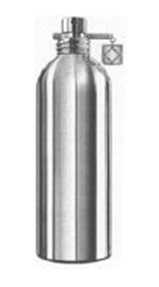Shape mark: form of a drinking bottle lacks distinctiveness in relation to perfumes
A recent judgement of the Swiss Federal Administrative Court highlights the strict practice for the registration of shape marks. The court ruled that a 3D mark for perfumes cannot be entered in the trade mark register for perfumes in Class 3, since it shall belong to the public domain according to Art. 2 lit. a of the Swiss Trade Mark Protection Act (MSchG).
The Court says that the overall appearance of the cylindrical container, the short neck and the small cylindrical lid characterizes a large number of perfume bottles available on the Swiss market. The small cylindrical stopper and the square pendant, which is hung on a small loop at the end of the stopper, are also commonplace. The individual three-dimensional elements of the bottle were therefore regarded as banal. Since the trivial 3D elements are also not combined in a particularly original way, the Court held that there is an elementary sign within the meaning of Art. 2 lit. a MSchG.
The Federal Administrative Court subsequently acknowledged that a trivial 3D sign in itself does not belong to the public domain if it has distinctive two-dimensional elements on its surface, such as lettering, graphic elements or colours, which have a significant influence on the overall impression it creates. However, in the present case, the Court considered the graphic two-dimensional square embedded in the likewise square pendant as nothing other than an elementary form in another elementary form. It can therefore not help to give the sign in question distinctive character. The reflective, metallic surface was also judged to be free of any distinctive features, since there are many models whose surfaces are metallic and reflective.
According to the Federal Administrative Court, the sign in question thus belongs to the public domain within the meaning of Art. 2 lit. a MSchG. The complaint was therefore rejected and the decision of the Institute of Intellectual Property (IPI) was confirmed.
The procedure once again illustrates the very strict attitude towards shape marks in Switzerland. From this point of view, the decision is hardly surprising. Another question, however, is whether this practice is appropriate. In the present case, the question arises as to whether the shape of a drinking bottle may truly be qualified as a banal shape of a perfume bottle. The choice of an obviously unfamiliar form of packaging for a product – such as an outdoor drinking bottle for perfume, which is usually only hardly drinkable – should be sufficiently unusual to make it recognizable for the consumers and to give it a distinctive character.
_____________________________
To make sure you do not miss out on regular updates from the Kluwer Trademark Blog, please subscribe here.



